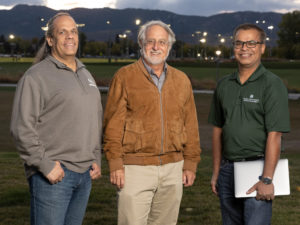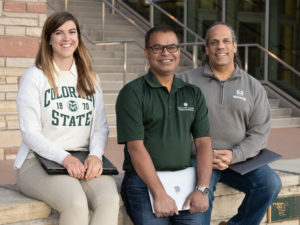
For decades education researchers have struggled with a stubborn problem: computer science introductory courses are notoriously difficult. About one third of the students fail or drop out.
To meet the urgent need for computing professionals, we must train and graduate more computer science majors. That means students need to pass beginning computer science courses (CS1 and CS2). How can universities improve student performance and retention in these initial courses?
Previous solutions focused on making small changes to teaching methodology, but a new CSU research group – Computer Science Education (CSedU) – tried an innovative idea.
They first redesigned the CS1 course from the ground up using spiral methodology, which improved performance 9%, increased retention of women 19% and helped students recall information in future courses.
Next, researchers identified at-risk students in CS2 and offered them a voluntary study skills intervention that leveraged techniques grounded in psychology. Every intervention participant passed the course with a grade of C or better, and the group’s DFW rate (a grade of D, F, or withdraw) plummeted from 59% to zero.
These results have been peer reviewed and accepted for publication at the premier conference for computer science educators, the 2022 Special Interest Group on Computer Science Education (SIGCSE) Technical Symposium on Computer Science Education.
CSedU’s novel research is supported by the Center for Inclusive Computing at Northeastern University and aligns with the computer science department’s BRAID mission, using research-driven practices to improve diversity, equity and inclusion.
“One of the many benefits of paying attention to diversity is that it shines a light on things we can do better,” said Craig Partridge, computer science department chair. “For years our introductory courses have been taught in a specific way, but as we focus on improving the educational experience of women in computer science, we’re learning better ways to teach computer science for everyone.”
Reinventing CS1

Most CS1 courses teach students not only how to read and write a new language, but also one of the hardest skills to learn – computational thinking.
In our data-driven world, problems are large with mountains of data and issues surrounding each problem. Computational thinking approaches these problems by focusing on four broad areas: abstraction, decomposition, pattern recognition and algorithmic design.
The CSedU group calls this approach “divide-conquer-glue.” Divide a problem into smaller parts until you can solve a single component of the problem. Then glue the individual solutions back together in unique and creative ways until a final solution emerges.
Computer science students have to learn computational thinking, remember cumulative concepts, and know how to study them. That’s a big cognitive load, and study skills are not directly taught in CS1.
The CSedU team was challenged to create a CS1 course that naturally promotes computational thinking skills and the ability to actively recall information.
They settled on spiral course design, first developed for a previous CSU course offering and based on study principles being researched by psychology and education. Spiral design uses five principles for improving memory and recall: spacing, interleaving, practiced recall, elaboration and reflection. The spiral method involves repeatedly covering the same topic, going into more depth or adding more elements each time.
Before implementing the new CS1 design in Fall 2020, the project was meticulously constructed. Class sections were set up to enable research assessment. Course labs were built from scratch because no physical textbook matched the spiral design. An online textbook for a traditional course was adapted, reorganizing sections and adding new labs. Every CS1 topic that had been taught in the traditional way was broken up into smaller components.
The course began with the first spiral pass teaching the smallest possible component of a topic. Every 2-4 weeks another component of that topic was added, allowing students to quickly use the concept. Each pass revisited the topic in more depth, and multiple topics were interleaved each week. Peer instruction, discussion, and practical projects helped with elaboration. Short weekly quizzes allowed students to practice recall, and they submitted written feedback on what they learned after each project.
At the end of the semester, the new CS1 design improved the median final exam grade 9% compared to those who learned via the traditional best practices design. The retention of women also increased 19%.
Students who learned via the spiral design showed improved recall in CS2. They outperformed their peers by 10-12.5% on a review exam and continued to outperform them throughout the semester. But what about students who didn’t learn via the spiral method or who need more support in CS2?
Boosting study skills in CS2

Education interventions are programs that help students improve in a particular area. There are many to choose from that can boost student grades and retention, but they have one glaring flaw – they assume students know how to study.
The researchers tracked the CS1 cohort’s performance in CS2 and devised a novel intervention for struggling students.
Using the same five spiral principles implicit in CS1, the team created a “booster” study skills section for CS2. Students were identified and targeted for the voluntary intervention based on first exam performance. For the remainder of the course, these at-risk students participated in activities to improve their study habits and were held accountable for their practice.
Twice a week for an hour, a graduate teaching assistant presented the students one of the five spiral principles using relevant research papers and slides built for the course. Using the principle as a foundation, students then prepared course study cards containing exam-like questions that involved code interpretation and problem solving. A daily reflective journal helped students track study time, consider what they had learned, and pinpoint areas needing more work.
The intervention results were impressive. All of the students who took the booster passed CS2, and their median grade jumped from 58% on the first exam to 73% on the final. Across 3 semesters (Spring 20, Fall 20, Spring 21) every student who fully participated in the intervention passed CS2 with a C or better after receiving a failing grade on the first exam. By contrast, 59% of the students who were targeted for the booster section but didn’t take it failed CS 2.
The CSedU team discovered that teaching students how to study, while also holding them accountable to those habits, significantly increased their success.
Creating computational thinkers
CSedU research sits at the high-pressure intersection of computer science and education. The products of computer science are increasingly complex, indispensable, and when made poorly, irritating.
After publishing their results in two papers at SIGCSE 2022, the fledgling research group will use the same spiral principles to enhance the student experience for learning computer science.
The CSedU team leverages the best practices from education, psychology and sociology to create innovative teaching techniques that improve student performance and retention. They are currently exploring computer science curriculum development, group programming and group interactions, integrating artificial intelligence as teaching assistants in classrooms, and ways to combine the depth of computer science with the needs of education.
CSedU welcomes collaborations, recognizing that group problem solving often produces the best solutions. To learn more about CSedU research, please contact Albert Lionelle and look for these papers to be published at SIGCSE in March 2022:
“Increase Performance in CS 2 via a Spiral Redesign of CS 1” by curriculum specialist Albert Lionelle, professor Sudipto Ghosh, instructor Benjamin Say and professor Ross Beveridge.
“Increase Performance and Retention: Teach Students How to Study” by curriculum specialist Albert Lionelle, professor Sudipto Ghosh, master’s student Shannon Ourada and alumnus Westin Musser.
The Department of Computer Science is in the College of Natural Sciences.